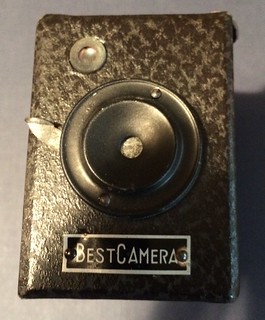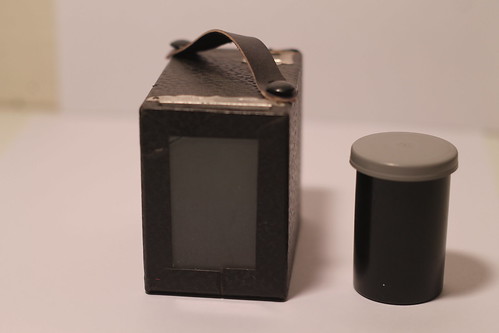Best Camera (no-need-darkroom)
|
| ||||
The Best Camera is a Japanese camera using the no-need-darkroom process.
Reportedly advertised in 1931
A no-need-darkroom camera called "Best Camera" or "Vest Camera" (ベストカメラ)[1] was reportedly advertised by the company Tōkyō Kamera Shōkai from September 1931, at the price of ¥2.80 for a set.[2] It is probably related to the surviving camera described below.
Surviving examples
One example of a folding camera using 4×6cm no-need-darkroom film sheaths is pictured in Sugiyama, where it is attributed to a "Best Camera Co." for some reason.[3] It is shaped as a roll-film folder, with rounded ends and a handle at the top. The folding bed is made of metal. The front standard needs to be manually pulled out of the body after opening the bed. There is a small brilliant finder atop the front standard, to the photographer's left.
The shutter reportedly gives Instant exposure only. The shutter plate has the words SPECIAL and BEST CAMERA inscribed above the lens, and HIGH CLASS LENSE and NO NEED DARK ROOM below. The word Special is repeated on the standing leg. The camera is presented as the "Best Special Camera" in Sugiyama, but the name might be read "Special Best Camera" as well.
This camera might be related to the Special Camera plate folder, which is attributed to the same "Best Camera Co." in Sugiyama.
A simple box camera, with a brilliant finder and a simple shutter certainly giving B exposures only, is also pictured in McKeown with the name BEST CAMERA inscribed on a nameplate attached under the lens.[4]
Notes
- ↑ The name ベスト in katakana script usually corresponds to the English word "Vest", as in Vest Pocket Kodak or Vest-film, which is the way 127 film was called in Japan. However this camera was perhaps related to the surviving "Best Camera".
- ↑ Date, price and attribution to Tōkyō Kamera Shōkai: Awano, p.7 of Camera Collectors' News no.317, quoting the book Nihon Shashinshi Nenpyō (日本写真史年表).
- ↑ Sugiyama, item 4026.
- ↑ McKeown, p.1032.
Bibliography
- Awano Mikio (粟野幹男). "Tougō kamera (4)" (トウゴーカメラ[4], Tougo cameras [4]). In Camera Collectors' News no.317 (November 2003). Nishinomiya: Camera Collectors News-sha. Pp.7–12.
- McKeown, James M. and Joan C. McKeown's Price Guide to Antique and Classic Cameras, 12th Edition, 2005-2006. USA, Centennial Photo Service, 2004. ISBN 0-931838-40-1 (hardcover). ISBN 0-931838-41-X (softcover). P.1032.
- Sugiyama, Kōichi (杉山浩一); Naoi, Hiroaki (直井浩明); Bullock, John R. The Collector's Guide to Japanese Cameras. 国産カメラ図鑑 (Kokusan kamera zukan). Tokyo: Asahi Sonorama, 1985. ISBN 4-257-03187-5. Item 4026.

